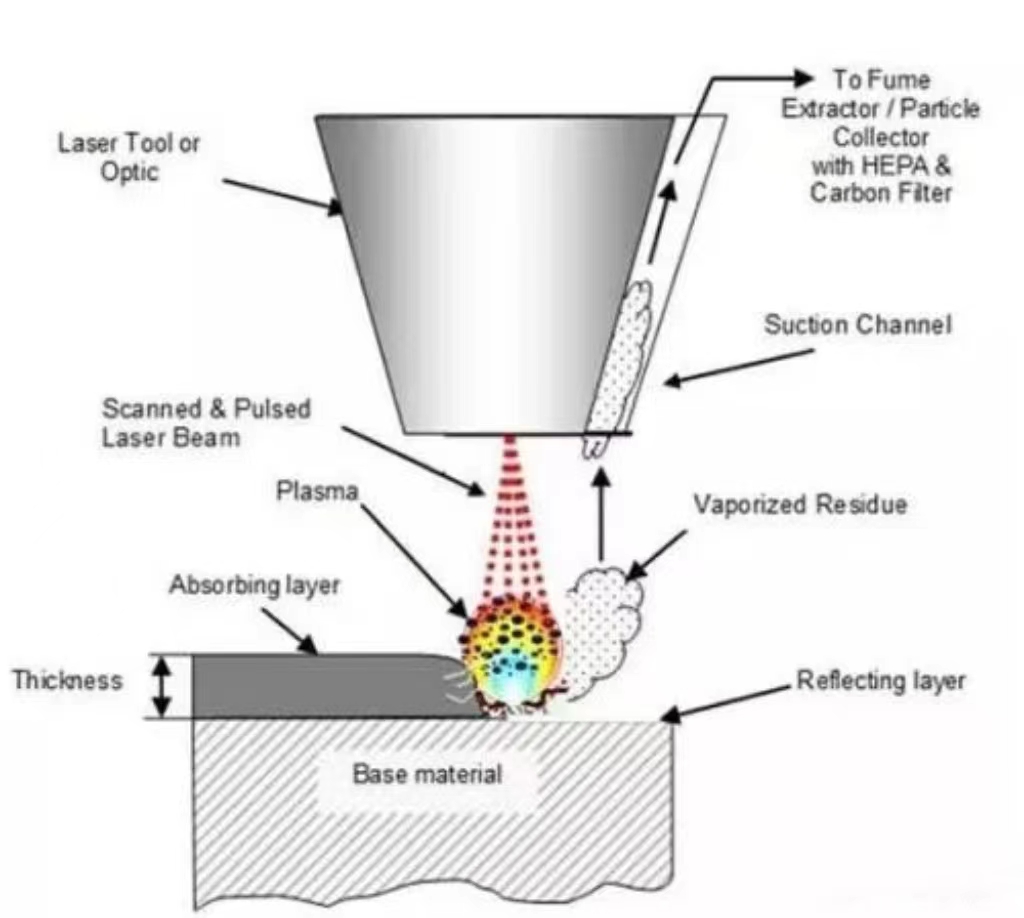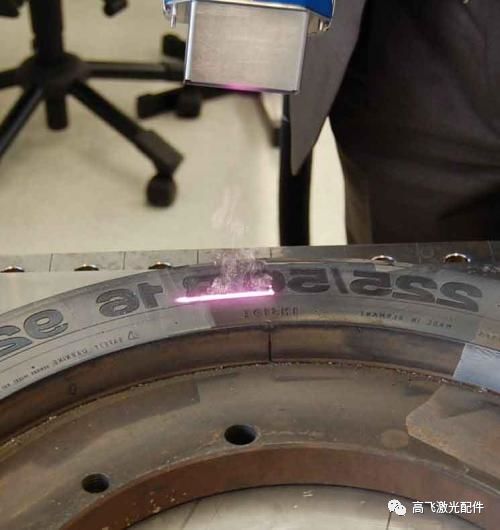There are various cleaning methods in the traditional cleaning industry, most of which use chemical agents and mechanical methods for cleaning. Today, as my country’s environmental protection regulations become more and more stringent and people’s awareness of environmental protection and safety is increasing, the types of chemicals that can be used in industrial production cleaning will become fewer and fewer.
How to find a cleaner and non-damaging cleaning method is a question we have to consider. Laser cleaning has the characteristics of non-abrasive, non-contact, no thermal effect and suitable for objects of various materials. It is considered to be the most reliable and effective solution. At the same time, laser cleaning machines can solve problems that cannot be solved with traditional cleaning methods.
Laser Cleaning Diagram
Why can laser be used for cleaning? Why does it not cause damage to the objects being cleaned? First, let’s understand the nature of laser. To put it simply, lasers are no different from the light (visible light and invisible light) that follow us around us, except that lasers use resonant cavities to focus light in the same direction, and have simpler wavelengths, coordination, etc. The performance is better, so in theory, light of all wavelengths can be used to form lasers. However, in fact, there are not many media that can be excited, so the ability to produce stable laser light sources suitable for industrial production is quite limited. The most widely used ones are probably Nd: YAG laser, carbon dioxide laser and excimer laser. Because Nd: YAG laser can be transmitted through optical fiber and is more suitable for industrial applications, it is also often used in laser cleaning.
Advantages:
Compared with traditional cleaning methods such as mechanical friction cleaning, chemical corrosion cleaning, liquid-solid strong impact cleaning, and high-frequency ultrasonic cleaning, laser cleaning has obvious advantages.
1. Laser cleaning is a “green” cleaning method, without the use of any chemicals and cleaning solutions, cleaning down the waste is basically a solid powder, small size, easy to store, recyclable, can easily solve the problem of environmental pollution caused by chemical cleaning;
2. Traditional cleaning methods are often contact cleaning, cleaning the surface of the object has a mechanical force, damage to the surface of the object or cleaning medium attached to the surface of the object to be cleaned, can not be removed, resulting in secondary contamination, the laser cleaning of non-abrasive and non-contact so that these problems are solved;
3. Laser can be transmitted through fiber optics, with robots and robots, convenient to achieve long-distance operation, can clean the traditional methods are not easy to reach the parts, which in some dangerous places to use can ensure the safety of personnel;
4. Laser cleaning is efficient and saves time;
Principles:
The process of pulsed fiber laser cleaning depends on the characteristics of the light pulses generated by the laser and is based on the photophysical reaction caused by the interaction between the high-intensity beam, the short-pulse laser and the contaminated layer. The physical principle can be summarized as follows:
Laser Cleaning Schematic
a)The beam emitted by the laser is absorbed by the contaminated layer on the surface to be treated.
b)The absorption of large energy forms a rapidly expanding plasma (highly ionized unstable gas), which generates a shock wave.
c)The shock wave causes the contaminants to fragment and be rejected.
d)The width of the light pulse must be short enough to avoid destructive heat build-up on the treated surface.
e)Experiments have shown that plasma is generated on metal surfaces when there is oxide on the surface.
Practical applications:
Laser cleaning can be used to clean not only organic pollutants, but also inorganic substances, including metal rust, metal particles, dust and so on. The following describes some practical applications, these technologies are very mature and have been widely used.
Laser tire cleaning diagram
1. Cleaning of molds
With hundreds of millions of tires made each year by tire manufacturers around the world, the cleaning of tire molds during production must be quick and reliable to save downtime.
Laser cleaning tire mold technology has been used in a large number of tire industry in Europe and the United States, although the initial investment costs are high, but can save standby time, avoid damage to the mold, work safety and save raw materials on the gains made by the rapid recovery.
2. Cleaning of weapons and equipment
Laser cleaning technology is widely used in weapons maintenance. The use of laser cleaning system can efficiently and quickly remove corrosion and pollutants, and can select the removal site to realize the automation of cleaning. With laser cleaning, not only is the cleanliness higher than that of chemical cleaning processes, but there is virtually no damage to the surface of the object.
3. Removal of old aircraft paint
In Europe laser cleaning systems have long been used in the aviation industry. The surface of an airplane has to be repainted after a certain period of time, but the old paint needs to be completely removed before painting.
Traditional mechanical paint removal methods are prone to damage to the metal surface of the aircraft, posing a potential risk to safe flight. If multiple laser cleaning systems are used, the paint layer on the surface of an A320 Airbus can be completely removed within three days without damaging the metal surface.
4. Cleaning in the electronics industry
Laser oxide removal for the electronics industry: The electronics industry requires high-precision decontamination and is particularly well suited for laser oxide removal. Before circuit board soldering, component pins must be thoroughly de-oxidized to ensure optimum electrical contact, and the pins must not be damaged during the decontamination process. Laser cleaning meets the requirements for use and is so efficient that only one laser exposure is needed for one pin.
Post time: Oct-19-2023



